Adult CPR, AED and Choking
Playlist includes 8 training videos
A vital and essential skill that could end up saving someone’s life is CPR. Providing breaths and pressing on the chest (compressions) are two key components of CPR. Adult CPR is performed on any person who is past puberty. There are special considerations for CPR when administered to young children and infants.
Adult CPR
Rescue breathing, airway management, and chest compressions are all components of CPR that a provider must be familiar with. The most important factor that gives a person the best chance to recover when delivering high-quality CPR is beginning with high-quality chest compressions. The blood circulates to the brain and the heart due to chest compressions. It’s recommended to perform 100 to 120 beats per minute at a depth of 2 to 2.4 inches (5 to 6 cm) for high-quality chest compressions.
The importance of early initiation of CPR by lay rescuers has been re-emphasized by the 2020 ILCOR Guidelines for CPR. The risk of harm to the patient is low if the patient is not in cardiac arrest. Bystanders should not be afraid to start CPR even if they are not sure whether the victim is breathing or is in cardiac arrest.
When the person is unresponsive and is not breathing or only gasping for air, provide CPR.
Do the following for adult CPR:
- Assess the safety of the scene and make sure the person is safe.
- Tap the person and ask loudly, “Are you okay?”
- Get help—yell for help and call 911/EMS with a cellphone; if possible, send a bystander for an AED.
- Check the person’s breathing.
- Start CPR if the person does not respond and if there is no breathing or only troubled breathing.
- You must deliver 30 compressions at a rate of 100 to 120 beats per minute and a depth of 2 to 2.4 inches (5 to 6 cm). Before you start each compression, let the chest rise back up.
- Give two breaths after opening the airway.
Continue delivering breaths and compressions until the person responds, until advanced help arrives, or until the AED is available.
Lay rescuers trained in chest compression-only CPR should give compression-only chest CPR for adults needing resuscitation. For lay rescuers trained in CPR using chest compressions, ventilation, and rescue breaths, it is reasonable to provide ventilation, rescue breaths, and chest compressions for the adult in cardiac arrest.
Only use the “hands-only” CPR method if you are an untrained rescuer.
This means no breaths and only continuous compressions.
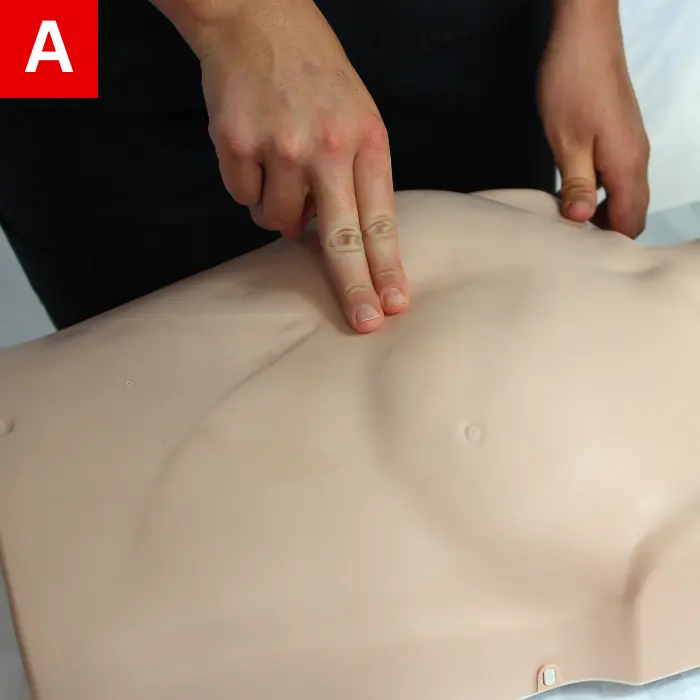
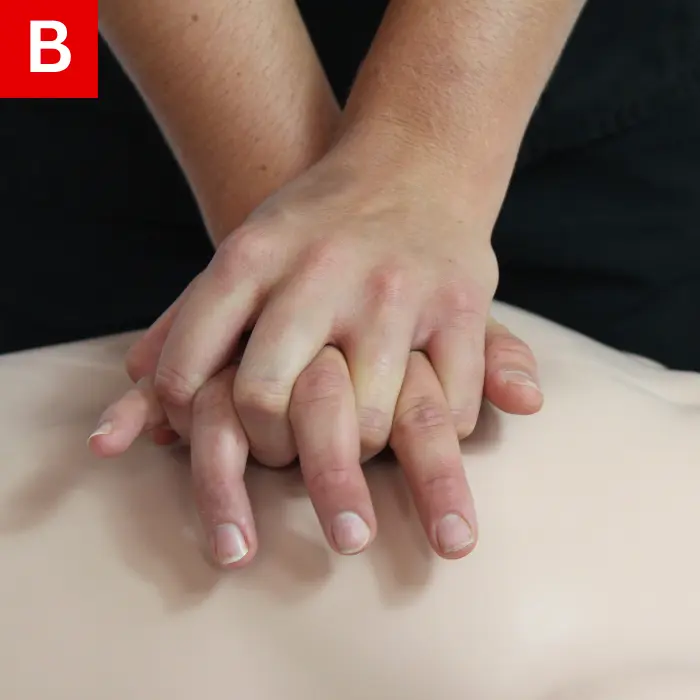
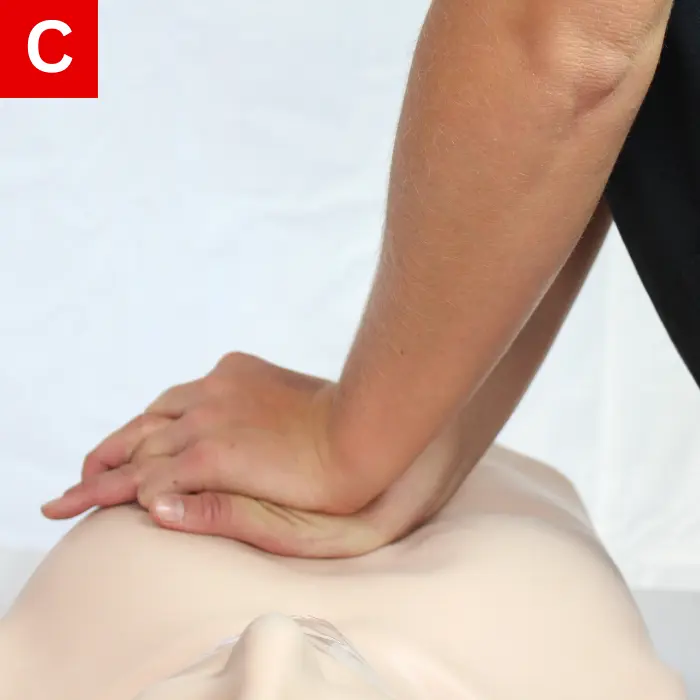
Figure 14
Compressions
The factor that has the greatest impact on a person’s survival is chest compressions. Rescuers usually make the mistake of not pushing fast or hard enough. To make sure you have the best chance of saving a life, you must deliver high-quality chest compressions.
Deliver chest compressions at a rate of 100 to 120 beats per minute and at a depth of between 2 to 2.4 inches (5 to 6 cm) for adults in cardiac arrest. You will not provide enough time for the heart to fill between each compression if you press faster than 120 beats per minute, and you are not likely to stimulate enough circulation to the heart, brain, and other vital organs if you press slower than 100 beats per minute. You also risk not providing adequate blood flow if you don’t press deeply enough, and you risk injuring the person if you press too deeply.
For chest compressions, do the following:
- Find a firm, flat surface to position the person on their back.
- If needed, clothing at the neck and chest area should be opened or removed.
- Find the end of the breastbone (sternum). (Figure 14a)
- On the lower half of the breastbone, press the heel of your first hand. You risk breaking off the bony tip of the breastbone (the xiphoid process) and slashing the liver, causing internal bleeding, if you press down at the end of the breastbone. On top of your first hand, place your second hand. (Figure 14b)
- Press straight down at a rate of 100 to 120 beats per minute at a depth of 2 to 2.4 inches (5 to 6 cm). (Figure 14c)
- Without bouncing or leaning on the person, your hands should remain in contact with the person while allowing the chest to recoil completely between each compression.
Proper CPR is often tiring to perform. If another rescuer is available to help, ask to switch positions when you become tired. Offer to switch up whenever fatigue sets in, monitor each other’s performance, and provide encouragement.
Giving Breaths
To maintain the supply of oxygen in the lungs, it is important to give breaths during CPR. The chest compressions circulate oxygen to the brain and the vital organs and the breaths assist with oxygen flow as well. While direct mouth-to-mouth can be performed in an emergency, the preferred method involves using a mask. The person’s chest will rise after a correctly executed breath.
Do the following to open the person’s airway:
- Place one hand on their forehead (Figure 15a).
- On the bony part of their chin, place your fingers (Figure 15b).
- Lift the chin and gently tilt the head back (Figure 15c).

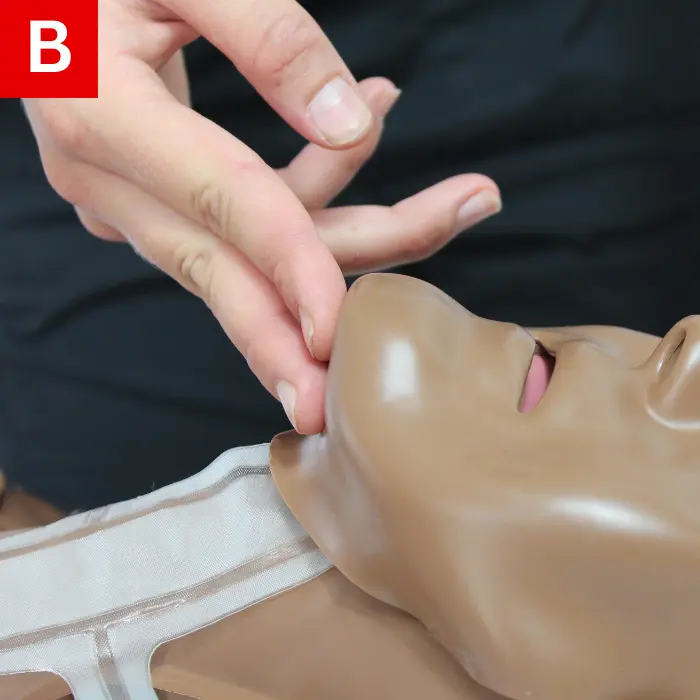
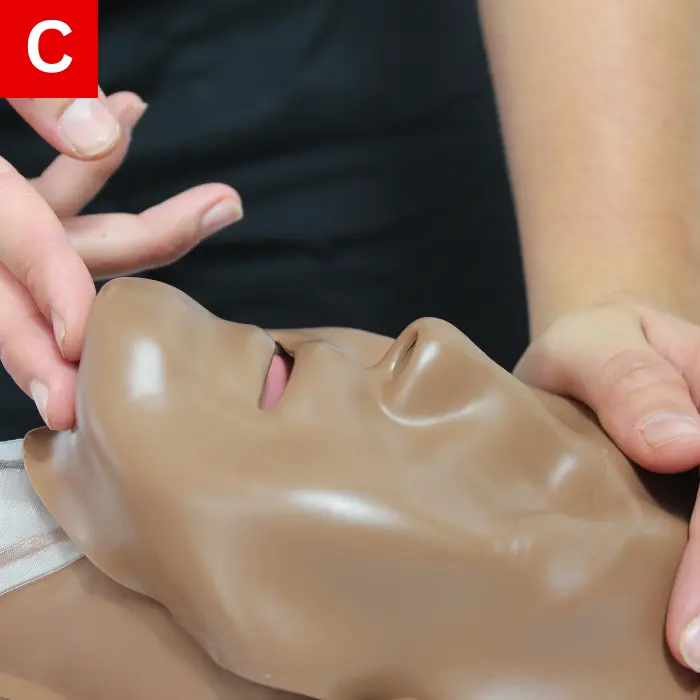
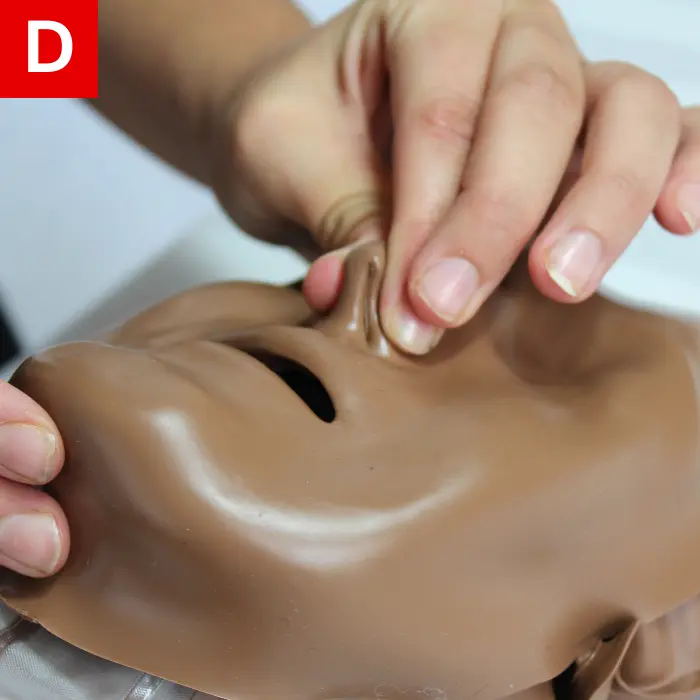
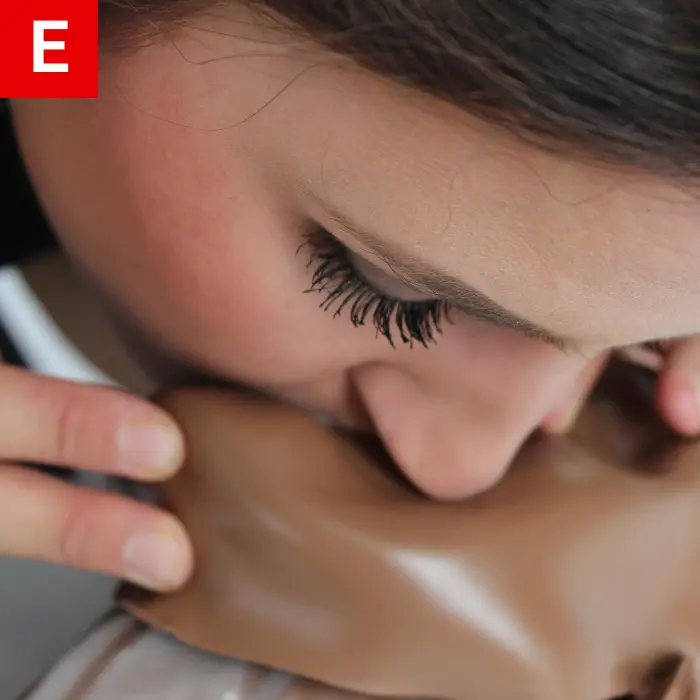
Figure 15
Do the following to give breaths:
- Pinch the person’s nose shut and hold their airway open (Figure 15d).
- Breathe deeply, then secure your mouth around the person’s mouth (Figure 15e).
- Watch their chest rise as you blow for one second into their mouth.
- Repeat with a second breath.
Reposition the airway if the chest does not rise. Return their head to a normal position and then repeat the chin-lift/head-tilt maneuver. Look for the chest to rise with another breath.
Without interruption, perform the chest compressions. Two breaths should take no longer than 10 seconds. Begin chest compressions again if the chest fails to rise in 10 seconds.
Mask Use
Generally, including when giving breaths, CPR is safe. However, use a mask whenever it is available. Fit the mask over the victim’s nose and mouth. The pointed end of the mask should be fitted over the bridge of the person’s nose.
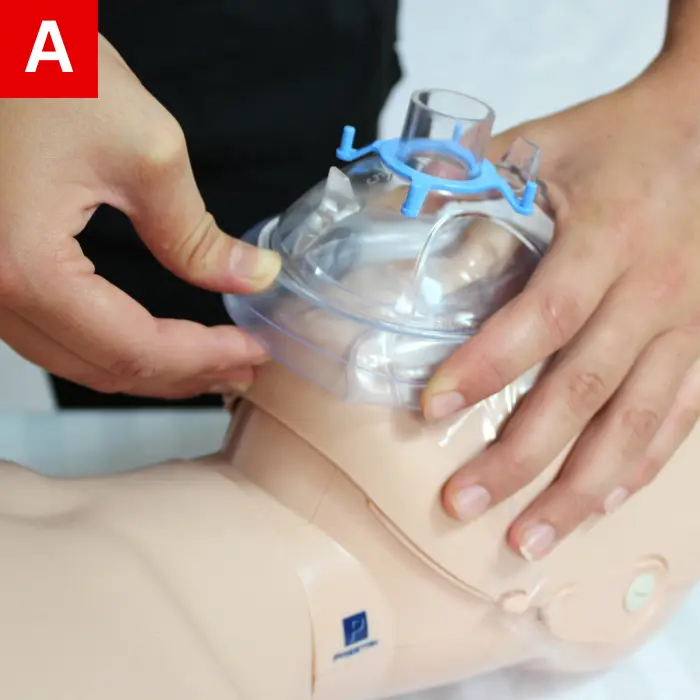
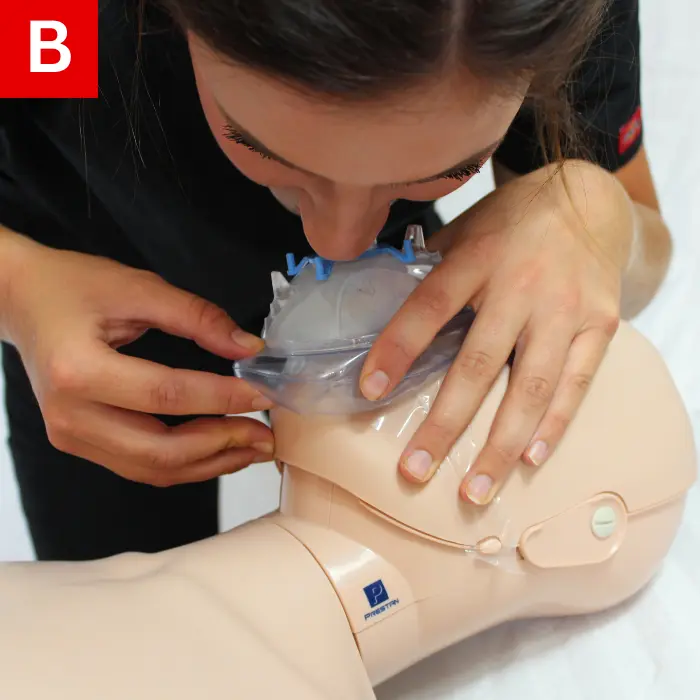
Figure 16
Do the following when using a mask to give breaths:
- Secure the mask over the person’s nose and mouth (Figure 16a).
- Perform the head-tilt/chin-lift maneuver to open their airway.
- Ensure that there is a secure seal between the mask and the person’s face.
- Watch the chest rise as you give a breath for more than one second (Figure 16b).
- Deliver a second breath.
AED for Adults
A person may collapse when his or her heart does not work properly. An AED can deliver a shock to help the heart restart its normal rhythm. The heart rhythm is analyzed by the computer inside the portable unit to help determine whether a shock is needed or not. You greatly improve the person’s chance of survival by quickly beginning CPR and then using an AED.
Send someone else to search for an AED while you begin CPR if an AED is not quickly available.
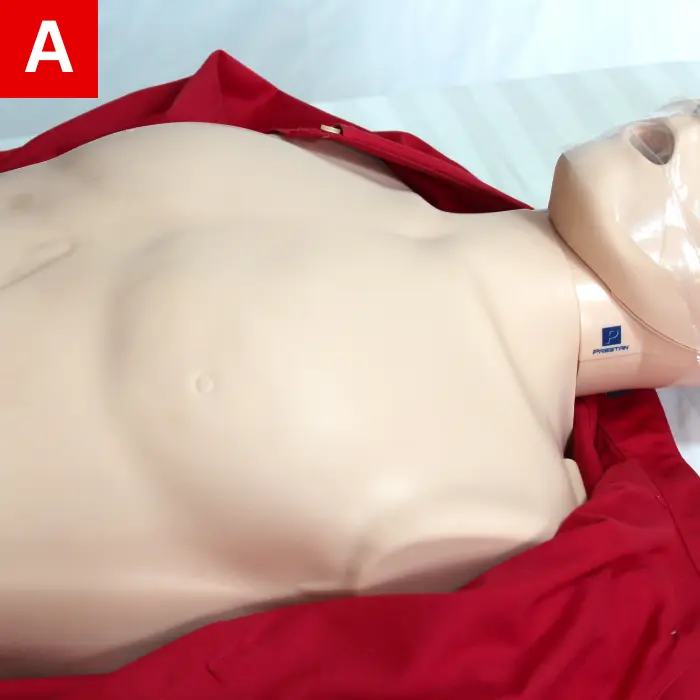
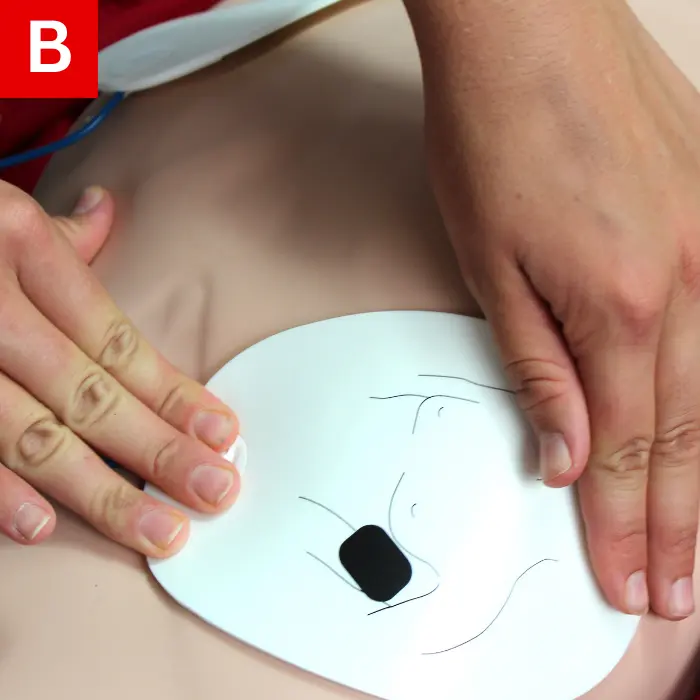
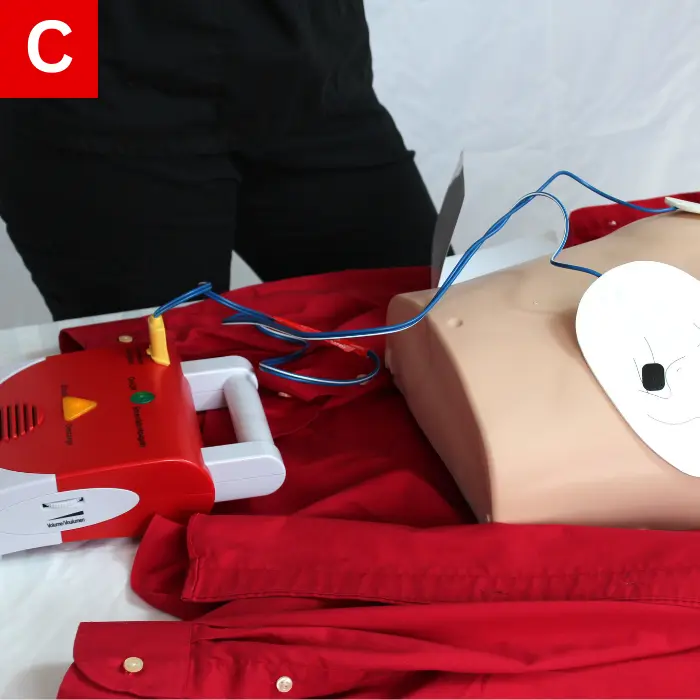
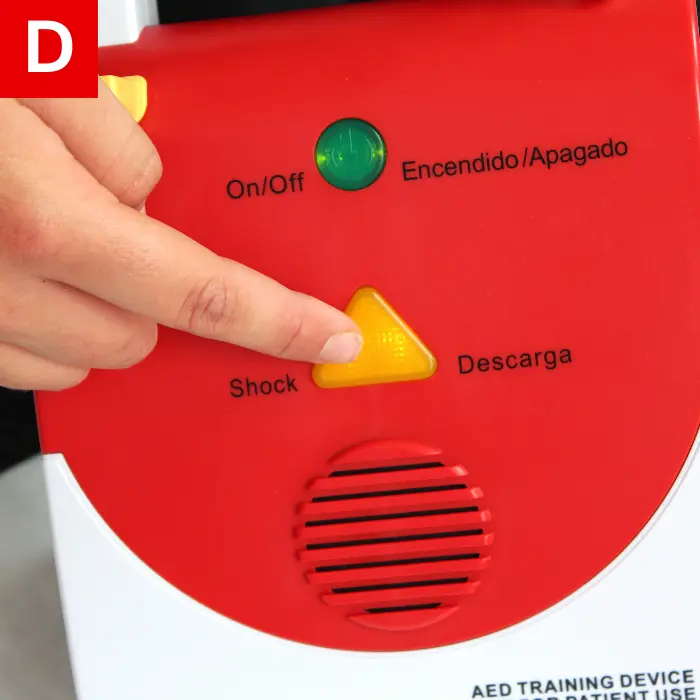
Figure 17
Any time a person fails to respond and is only gasping; collapses; or is barely breathing, an AED should be used. Follow the prompts that you hear and see after you turn on the AED.
The AED can be very simple to use when you follow the provided instructions. The computer will determine whether a shock is needed after the pads have been applied. If the AED advises administering a shock, make sure that no one is in contact with the person.
Do the following to use an AED:
- Turn it on.
- Reveal the person’s chest (Figure 17a).
- Apply the pads properly (Figure 17b).
- Connect the pads.
- Clear the person; ensure that no one is touching the person, including yourself (Figure 17c).
- Let the AED analyze the rhythm.
- Follow the AED’s prompts such as (Figure 17d): Shock Advised, No Shock Advised, Check Connection, etc.
- Begin compressions again.
Before applying AED pads, remove any medication patch the person may have on their chest. A pacemaker may be present if there is a bulge under the skin of their chest. Adjust placement of the pads accordingly, and avoid placing AED pads over this device. Continue performing CPR until additional help arrives if the AED does not work for any reason.
Activating EMS (Calling 911)
Call 911/EMS whenever you encounter a person who is having trouble breathing or who is unresponsive. The first step in the Chain of Survival is dialing 911 immediately, or call the appropriate emergency number. It is important to use a cellular phone to activate EMS without abandoning the person. While delivering care to the person, use the speakerphone function to communicate with the 911/EMS operator.
Do not leave the injured or ill person alone, so if no mobile phone is available, send a rescuer or bystander to call AED and retrieve an AED and/or first aid kit.
When approaching an injured or ill person, it is important to make sure the scene is safe. You will become another person to be taken care of by rescuers and you will be unable to help the person if you become injured or disabled yourself.
The person is considered unresponsive if they fail to respond to a tap and a loud question, such as “Are you okay?” Get an AED if possible and send another person to call 911/EMS after yelling for help.
Do what the 911/EMS operator says, and stay on the line until the operator confirms that you can hang up. Staying with the operator will not delay the arrival of additional help and the operator can help you make decisions.
Check the person’s breathing after you have determined that the affected person is unresponsive. Begin CPR immediately if they are having trouble breathing or are only gasping, as gasping is generally ineffective, and often occurs in cardiac arrest (it is an abnormal sign).
Roll the person on their side if they are not responding but still breathing normally. This will prevent them from choking on vomit and keep their airway open. Start CPR if the condition worsens, so make sure to monitor their breathing.
Choking in Adults
When food or another object gets stuck in a person’s throat, choking can become a cause of death, but this is preventable. Immediate action is needed to treat the blocked airway. A choking person will generally pass out within a few minutes. If a person is holding their neck with one or both hands, this is a universal sign of choking.
| Degree of Obstruction | Responsiveness | Rescuers Actions |
|---|---|---|
| Mild Obstruction |
|
|
| Severe Obstruction |
|
|
Table 1
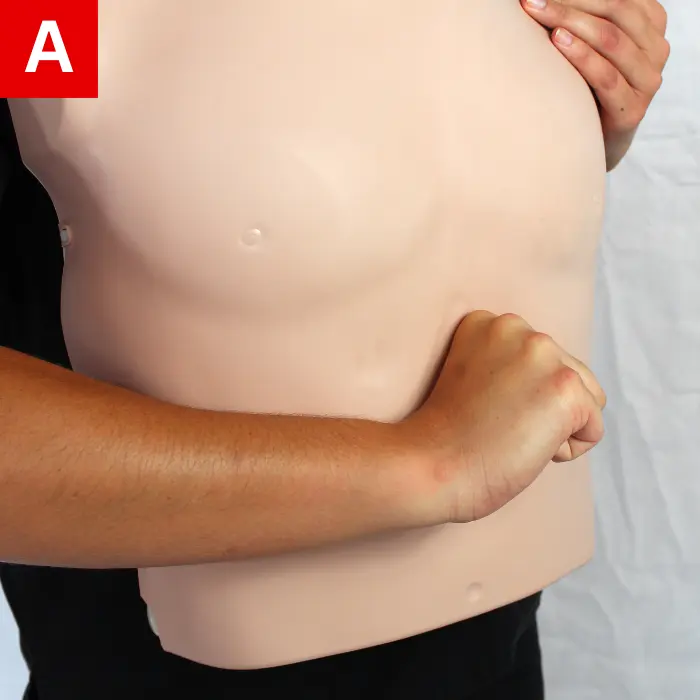
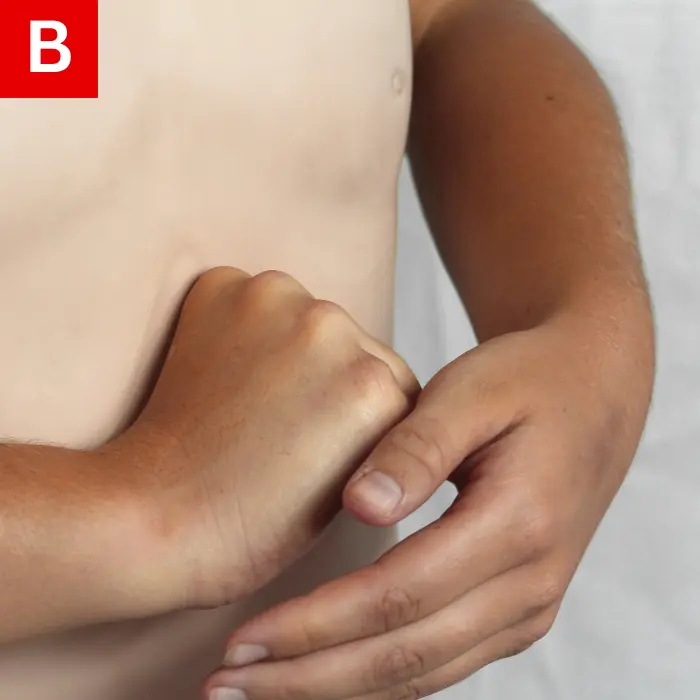
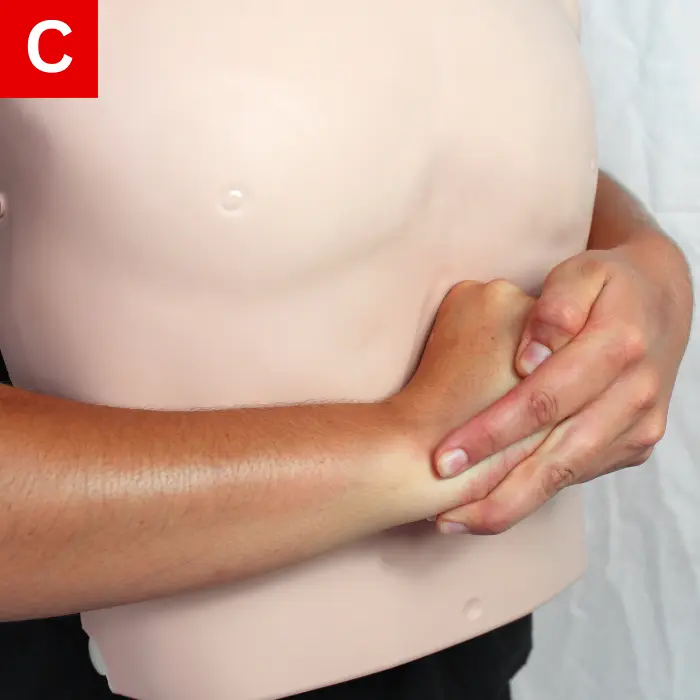
Figure 18:
Heimlich Maneuver
Relief of Choking
Abdominal Thrusts for Adolescents and Adults
- Wrap your arms around the person’s waist under the ribcage as you stand behind them (Figure 18a).
- Place your fists above the person’s navel in the middle of the belly (Figure 18b).
- Wrap your other hand around your first fist and press forcefully into the abdomen and up toward the person’s chest with your clasped hands (Figure 18c).
- If the obstruction is relieved, you can stop performing thrusts. Begin CPR if the person becomes unresponsive.
Chest thrusts can be performed on pregnant women and very large persons. In this scenario, do the following:
Wrap both arms around the person. Pull your arms straight back to deliver the chest thrusts.
